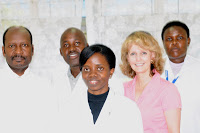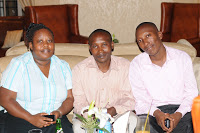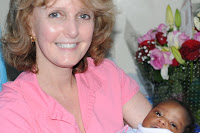
It’s with great pleasure and joy that I’ve returned to Kenya, in east Africa, to visit the patient groups and the patients I have grown so fond of over the past nine years. I first arrived in 2001, returned again last year and was eager to not wait eight years before returning again!
Kenya is best known nowadays in America for its elite athlete runners (one just won the Boston marathon last week) and as the ancestral home of our president. But it is very important for hemophilia care as its national hospital has become a training center for many in east Africa. There are an estimated 4,000 people with hemophilia in Kenya, and about 400 identified and registered. Yes, there is a long way to go in providing care, but seeing where it has come in nine years, it has been making steady progress.
I landed late last night after a six hours flight to London, an overnight stay and then an eight+ hour flight straight to Kenya. I was greeted by Maureen Miruka and partner Sitawa, parents of Ethan, who has hemophilia. Maureen founded the Jose Memorial Hemophilia Society to help organize patients with bleeding disorders and to provide programs that address their needs. Jose was Maureen’s first son, who died three years ago that same evening.
My first stop today was the Kenyatta University Hospital, to visit with the chief hematologist, Dr. Walter Mwanda, and the Kenya Haemophilia Association. We had a wonderful meeting and it was exciting to get caught up on the many outreach activities planned, and the ideas of their young president, James Kago, who has hemophilia. What devotion: James just became a father for the first time on Saturday, and here he was, attending to affairs of the state! Our meeting, originally a courtesy call, lasted three hours. We all share a deep passion for helping those suffering with hemophilia in Kenya, and it showed in our bubbling over of ideas and concerns and a pledge to help the KHA and all patients. (Photo: Dr. Wanda and KHA) 
Next stop: a visit with James’s new baby girl Tiffany! It’s been a long, long time since I have held a newborn and there is perhaps no greater joy.
Next stop was to meet at my hotel with Maureen and James, and also Geoffrey Mosongo, a young man with hemophilia who has established a new program to help young men with hemophilia get scholarships, finish school and find work. Geoffrey rightly recognizes the needs patients have as they mature to find employment. The meeting was to put heads together to find better ways to create results. I was very impressed with the level of respect and compassion each has for the other, and for each other’s organizations.
The meetings went on well into tonight, for we are ten hours ahead of Boston time.
Tomorrow I go off for a field visit about two hours outside of Nairobi, the capital, to meet with patients in their homes. Stay tuned!

The Kenyan Flag: The black stripe represents the African people; the red stands for the blood shed for independence. The green represents Kenya’s natural resources. The thin white stripes symbolize peace and unity. The central emblem is a shield of the indigenous Masai warriors.
Good Book I Just Read
Pooling Blood by Cheryl D’Ambrosio
This is the true story about two sisters with bleeding disorders (factor V deficiency), as told by their stepmother. It is absolutely compelling; a beautiful tribute to the story of Cheryl’s fight to keep the girls alive, and educate a medical community often ignorant of girls with bleeding disorders. From the opening scene of a blood smeared bathroom, to the blossoming of the girls socially at camp to a near-death experience while on a vacation, the book is a roller coaster of emotions and learning experiences. I started reading it while on the treadmill; three miles never flew by so fast! The book is a testament to advocacy and persistence, and Cheryl is a gifted storyteller.
The only places where the book falls short is when medical or industry related material is shared. The description on page 114 of Bayer’s Kogenate FS production stoppage is completely wrong; the explanation of volunteer versus paid blood donors is outdated and incomplete. The glossary however is very good. Readers should enjoy the story, learn from Cheryl’s experience and prepare to be very inspired.

